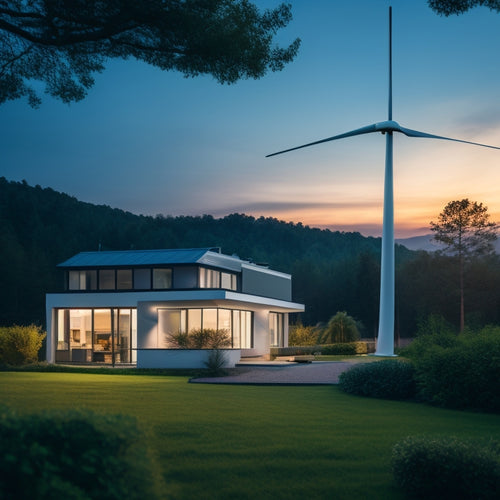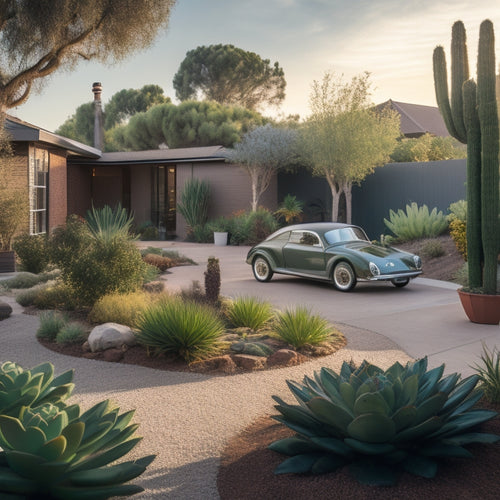
Compact Composting Solutions for Tiny House Living
Share
You're embracing the tiny house lifestyle, which means you need to get creative with waste management and adopt compact composting solutions that fit your unique space constraints. Consider investing in a composting toilet, which reduces water usage and minimizes odor issues. Popular brands include Nature's Head and Sun-Mar, with options ranging from self-contained toilets to built-in composting chambers. To make the most of your composting system, prioritize regular maintenance, including adding bulking agents and aerating the compost pile. By adopting these eco-friendly solutions, you'll be well on your way to minimizing your environmental footprint - and there's more to discover on this expedition to sustainable living.
Key Takeaways
- Compact composting toilets like Nature's Head and Sun-Mar offer reliable, low-water, and low-maintenance solutions for tiny house living.
- Effective waste management strategies include minimal packaging, recycling, and energy-efficient solutions to reduce environmental impact.
- Vermicomposting systems and portable composters are suitable compact composting solutions for tiny house living, converting waste into fertilizer.
- Space-saving compost bin ideas include vertical systems, kitchen composting, and compact models with built-in filters for odor management.
- Regular maintenance routines ensure smooth operation, minimize odors, and support sustainable living in tiny house environments.
Tiny House Composting Toilet Options
When it comes to tiny house living, one of the biggest challenges is dealing with waste, particularly human waste.
You'll need a reliable and efficient composting toilet system that fits your compact space. Look for composting toilet features that prioritize odor control, low water usage, and easy maintenance.
As companies like Anheuser-Busch and IKEA successfully electrify their fleets, it's crucial to evaluate the environmental impact of your tiny house.
Indoor composting options like self-contained toilets or toilet systems with built-in composting chambers are ideal for tiny houses. These systems typically use natural processes to break down waste, reducing your environmental impact.
Some popular options include Nature's Head, Sun-Mar, and Clivus Multrum. Research each brand's features and reviews to find the best fit for your tiny house lifestyle.
Waste Management for Small Spaces
Tackling waste management in small spaces requires getting creative with the resources you have. You'll need to adopt a minimalist waste approach to maintain a clutter-free and sustainable living environment.
Start by reducing your waste output by choosing products with minimal packaging, buying in bulk, and avoiding single-use items. By incorporating fast charging infrastructure into your daily routine, you can also reduce your carbon footprint.
Implementing energy-efficient solutions, such as solar-powered charging, can further minimize your environmental impact. Implement a recycling system and designate a specific area for collecting recyclables.
Consider investing in a portable waste sorting station or a compact recycling bin to optimize your space. By being mindful of your waste generation and taking proactive steps to manage it, you'll be able to enjoy the freedom and simplicity that comes with tiny house living.
Compact Composting System Designs
Every tiny house dweller needs a reliable compact composting system to turn food scraps and yard waste into nutrient-rich fertilizer.
You'll want a system that's efficient, easy to use, and takes up minimal space. Incorporating renewable energy solutions, such as solar panels, can further reduce your carbon footprint.
Vermicomposting systems, which use worms to break down organic matter, are a great option for tiny homes. These compact systems can be kept under the sink, in a closet, or even outdoors.
Portable composters are another great choice, allowing you to easily move them around your tiny space. Look for compact designs that fit your specific needs, such as compact tumblers or space-saving bokashi bins.
With the right compact composting system, you'll be turning waste into fertilizer in no time, and enjoying the freedom that comes with living off the grid.
Eco-Friendly Toilet Alternatives Exist
Designing a sustainable tiny home means rethinking traditional plumbing fixtures, including the toilet. You're likely aware that conventional toilets waste a significant amount of water and energy.
But did you know there are eco-friendly alternatives that can enhance your sustainable hygiene practices? In fact, adopting renewable energy solutions, such as solar power for EV charging, can also support climate action and reduce our reliance on fossil fuels.
Look into self-contained composting toilets, which break down waste into a beneficial fertilizer. These toilets use little to no water and reduce your carbon footprint.
Another option is incinerating toilets, which use electricity or gas to vaporize waste, leaving behind a small amount of ash. Both alternatives promote eco-friendly sanitation and can be a transformative factor for tiny house living.
Composting Toilet Maintenance Tips
With your composting toilet up and running, it's essential to stay on top of maintenance to confirm it continues to break down waste efficiently and hygienically.
You'll want to create a maintenance schedule to guarantee regular checks and tasks are completed. This includes adding bulking agents, like coconut coir or sawdust, to maintain the right carbon-to-nitrogen ratio.
You'll also need to turn the compost pile regularly to aerate it and speed up decomposition, much like how renewable energy sources are used to power EV charging stations.
Additionally, incorporating green roofs and rainwater harvesting systems into your tiny house design can further reduce your ecological footprint.
Don't forget to clean and inspect composting toilet accessories, like the urine extractor and vent pipe, to prevent clogs and odors.
Benefits of Waterless Toilets Systems
You've successfully implemented a composting toilet system and are now reaping the benefits of a reduced water footprint.
By ditching traditional flush toilets, you're conserving water, a precious resource, and reducing your impact on the environment.
Waterless toilet systems also offer superior odor control, as there's no water to facilitate bacterial growth and create unpleasant smells.
This means you can enjoy a fresher, more hygienic bathroom experience.
Plus, with composting toilets, you're turning waste into a beneficial resource - nutrient-rich compost for your garden.
It's a win-win for you and the planet.
Space-Saving Compost Bins Ideas
Beyond the toilet itself, effective composting requires a dedicated space to break down organic matter.
You'll need a compost bin that fits your tiny house lifestyle. For small spaces, consider vertical composting systems that stack layers of food scraps and leaves, maximizing space while minimizing odors.
Another option is kitchen composting, where you can turn food waste into nutrient-rich soil right in your kitchen.
Look for compact, odor-controlled bins that can fit under your sink or in a corner. Some models even have built-in filters or carbon filters to eliminate smells.
DIY Composting Toilet Solutions
You're likely considering DIY composting toilet solutions because you want to reduce your water usage and turn waste into a worthwhile resource.
When it comes to toilet options, you'll need to compare self-contained units, like bucket toilets or portable toilets, to more complex waste management systems that require piping and installation.
Toilet Options Compared
As you investigate the world of DIY composting toilet solutions, one essential aspect to contemplate is the type of toilet that will best suit your needs. You'll want to take into account factors like space, budget, and personal comfort when choosing between toilet types.
| Toilet Type | Odor Control | Cost |
|---|---|---|
| Self-Contained | Good | $500-$1,000 |
| Central Composting | Excellent | $1,000-$2,000 |
| Urine-Diverting Dry | Fair | $300-$800 |
| Bucket Toilet | Poor | $100-$300 |
When selecting a toilet, evaluate the level of odor control you need and how much you're willing to invest. Remember, the right toilet will guarantee a comfortable and convenient composting experience.
Waste Management Systems
Your DIY composting toilet solution isn't complete without a reliable waste management system to process the waste. This system is essential in capturing the composting benefits and achieving significant waste reduction.
You'll need a well-designed plan to collect, process, and employ the composted waste. Consider a combination of aerobic and anaerobic decomposition methods to break down the waste efficiently.
Implement a regular maintenance routine to guarantee the system runs smoothly and odors are minimized. By doing so, you'll reap the rewards of a self-sustaining waste management system, reducing your environmental footprint and enjoying the freedom that comes with tiny house living.
Self-Contained Units
Their own self-contained composting unit can be a revolutionary solution for tiny house dwellers, providing an efficient and eco-friendly way to manage waste.
With a self-contained unit, you can enjoy the benefits of composting without worrying about space constraints. These units are designed to be compact and portable, making them perfect for tiny house living. You can easily move them around or take them with you on the go.
The self-contained benefits of these units also mean you don't need to worry about odors or messes, as everything is contained within the unit. Plus, they allow for portable composting, giving you the freedom to compost anywhere, anytime.
This means you can turn your waste into priceless nutrients for your garden, reducing your environmental impact and living more sustainably.
Frequently Asked Questions
Can I Compost in a Tiny House With No Outdoor Space?
You can definitely compost in a tiny house with no outdoor space! Look into indoor composting methods like worm bins, which are perfect for small spaces and can turn your food scraps into nutrient-rich fertilizer.
Are Composting Toilets Suitable for Households With Many Users?
You're wondering if composting toilets can handle multiple users? Yep, they can! But, you'll need to prioritize user experience and maintenance tips, like frequent emptying and odor control, to guarantee a smooth, trouble-free experience for all users.
Do Composting Toilets Require Special Plumbing or Electrical Installation?
As you commence on this eco-friendly expedition, you'll find that composting toilets don't always require special plumbing or electrical installation; instead, you can opt for plumbing alternatives, like gravity-fed systems, that simplify the process and grant you the freedom you crave.
Can I Use a Composting Toilet in a Cold Climate or Winter?
You can totally use a composting toilet in cold climates or winter, but you'll need to make some cold weather adaptations, like extra insulation and regular composting toilet maintenance to keep it running smoothly and efficiently.
Are Composting Toilets More Expensive Than Traditional Toilets?
You're worried that composting toilets will break the bank, but hear this: they're actually cost-competitive with traditional toilets when you factor in lower water and maintenance costs - plus, you'll save on your water bill!
Related Posts
-

7 Best Automated Sprinklers for Water-Wise Green Homes
You're likely among the 75% of U.S. homeowners who use in-ground sprinkler systems, and coincidentally, you're also c...
-

10 Grid-Tied Wind Power Systems for Modern Homes
You're looking for a grid-tied wind power system to utilize wind energy for your modern home. Here are ten options to...
-

What Water-Saving Gardens Complement Electric Vehicle Ownership?
As you pair your electric vehicle with a water-saving garden, you're not only reducing your carbon footprint but also...


